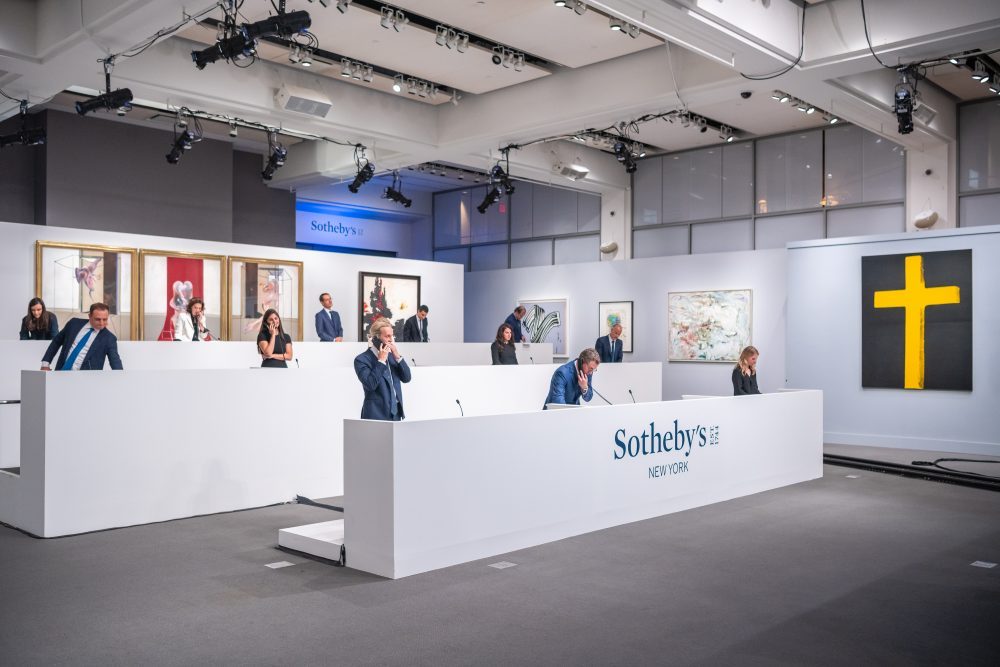[ad_1]
According to a new report published by a London art market analytics firm Pi-eX, the top three public auction houses—Christie’s, Sotheby’s, and Phillips—saw a 70 percent year-over-year drop in revenue during the second quarter of 2020. Whereas in 2019 the houses brought in $4.4 billion during the second quarter, this year they saw $0.9 billion during the same period. The dramatic decrease is more significant than the one that followed the 2008 financial crisis, when auction revenue fell from $4.8 billion in Q2 2008 to $1.6 billion in Q2 2009.
Pi-eX previously found that sale totals from the same auction houses had fallen 40 percent during the first quarter of 2020. In the quarter that followed, the houses staged hundreds of auctions in digital, live, and hybrid formats, with four live-streamed evening sales that each drew in excess of 150,000 viewers and together achieved a combined total of $1 billion between June 29 and July 28. The houses’ French outposts reportedly experienced the lowest drop in year-over-year revenue, falling 27 percent with live programming opening back up at the end of May.
According to Pi-eX, from August 2019 to July 2020, auction houses made $7.8 billion through sales—a number not even close to the $11.1 billion made during the same period between 2018 and 2019. The 2020 figure is the third-lowest total since 2009’s figure ($5.5 billion), and the second-lowest in the last decade, coming in just above the 2010 total of $7.3 billion. ArtTactic’s 2020 global auction report released in June said that, in comparison to the first half of 2019, the results of evening sales of Impressionist, modern, postwar, and contemporary art across New York, Hong Kong and London fell 57.3 percent in the first half of 2020.
Auction houses have moved online primarily out of necessity. According to the Pi-eX report, in Q2 2020, 84 percent of auctions arranged were online during the first two quarters of 2020, as opposed to 20 percent for that period in 2019. Sotheby’s alone said that, in the first seven months of 2020, its online sales results jumped a staggering 540 percent, posting a total in excess of $285 million. While revenue from online sales showed a robust 550% increase in Q2 2020’s result of $286 million versus $44 million in 2019, these digital channels do not come close to matching revenue brought in through the marquee live auctions, where more expensive works hit the block. The report shows that more than half of the second quarter’s auctions were held in the month of June and together generated 85% of the second quarter revenue. At the end of June, for example, Sotheby’s staged modern and contemporary art evening sale that achieved $363 million in results.
“The biggest takeaway for Q2 is that these live marquee sales are essential to the auction business and that so far, online auctions, which were the majority of auctions in Q2 2020, were not able to generate the level of revenue live auctions generate,” said Christine Bourron, CEO of Pi-eX. Due to a major shift in the auction calendar that saw several marquee sales pushed to July, the revenue posted in the third quarter will provide a more accurate picture of whether the market is recovering from the coronavirus pandemic, according to Bourron.
No in-person sales were held at the top three houses in April because of various restrictions. Then, in June, they returned, and revenues surged. But this did not make up for the loss of revenue earlier in the quarter, even though the volume of online sales across the houses has increased during the pandemic. In May 2020, across the three houses, $82 million worth of art was traded online—a number that came just shy of the selling price of the season’s top lot, a Francis Bacon triptych that sold at Sotheby’s for $85 million. (Most online sales brought in an average total between $1 million and $5 million.)
In a typical season, the top ten lots at auction account for between 40 percent and 50 percent of the evening sale’s total figure. Without those lots hitting the block, the houses suffered. After a mass expansion of their online platforms, auction houses tested how high collectors were willing to bid through digital channels in the live evening sales. In its June modern and contemporary sale, held via livestream, Sotheby’s received its highest historic online bid for the monumental Bacon painting of $73.1 million from a client in China.
Accordingly, the average lot price has dropped significantly, from $130,000 in the first two quarters in 2019 to $50,000 for that period in 2020. The figure comes close to the one for 2009, the year after the recession began, but there is one key difference: the number of lots consigned. This year so far, there have been 20,000 lots consigned; in 2009, during the second quarter there were 50,000. Officials at the houses have experienced difficulty in getting collectors to consign works during a pandemic. Phillips CEO Edward Dolman said in a post-sale press conference in July that it was a challenge to convince collectors to sell high-caliber works in a time of economic fragility.
[ad_2]
Source link


